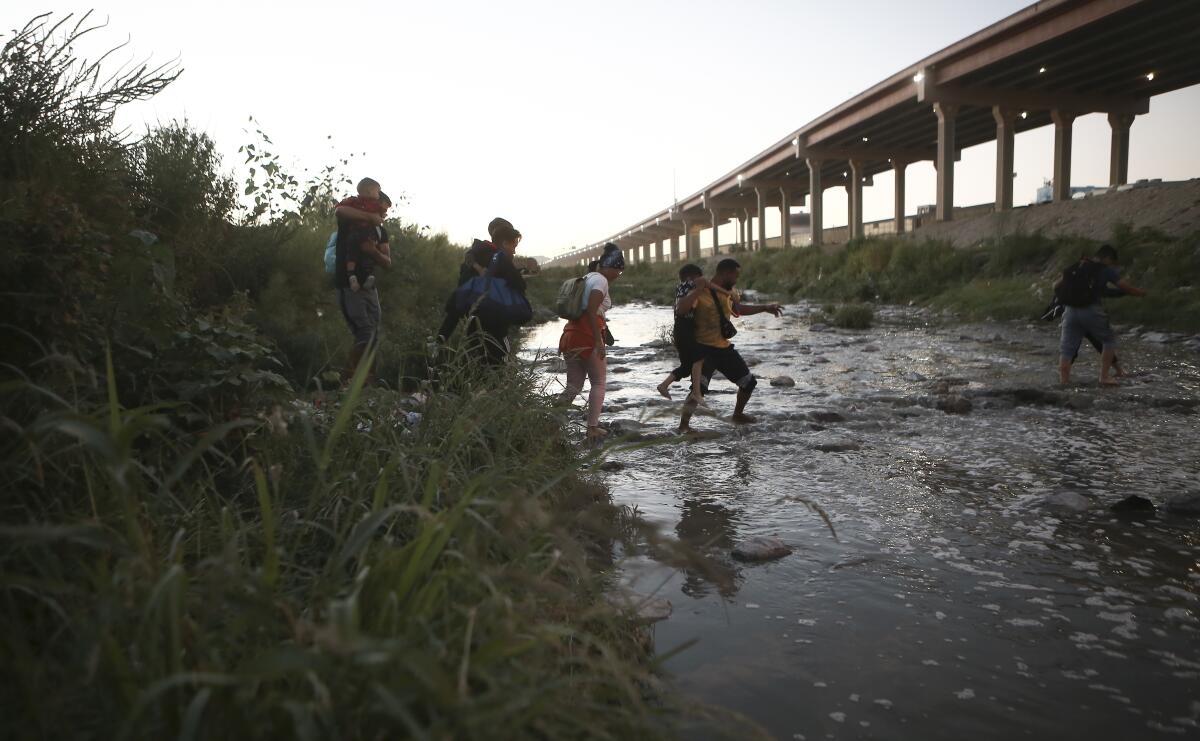
A new Biden administration policy has dramatically lowered the percentage of migrants at the southern border who enter the United States and are allowed to apply for asylum, according to numbers revealed in legal documents obtained by The Times. Without these new limits to asylum, border crossings could overwhelm local towns and resources, a Department of Homeland Security official warned a federal court in a filing this month.
The new asylum policy is the centerpiece of the Biden administration’s border efforts.
Under the new rules, people who cross through a third country on the way to the U.S. and fail to seek protections there are presumed ineligible for asylum. Only people who enter the U.S. without authorization are subject to this new restriction.
The number of single-adult migrants who are able to pass initial screenings at the border has dropped from 83% to 46% under the new policy, the Biden administration said in the court filing. The 83% rate refers to initial asylum screenings between 2014 and 2019; the new data cover the period from May 12, the first full day the new policy was in place, through June 13.
Since the expiration of Title 42 rules that allowed border agents to quickly turn back migrants at the border without offering them access to asylum, the administration has pointed to a drop in border crossings as proof that its policies are working.
But immigrant advocates and legal groups have blasted Biden’s new asylum policy, arguing that it is a repurposed version of a Trump-era effort that made people in similar circumstances ineligible for asylum. (Under Biden’s policy, certain migrants can overcome the presumption that they are ineligible for asylum.) The ACLU and other groups have sought to block the rule in federal court in San Francisco, in front of the same judge who stopped the Trump policy years ago.
The new filing provides the first look at how the Biden administration’s asylum policy is affecting migrants who have ignored the government’s warnings not to cross the border.
“This newly released data confirms that the new asylum restrictions are as harsh as advocates warned,” said Aaron Reichlin-Melnick, policy director at the American Immigration Council. “The data contradicts conservative attacks on the rule for being too lenient. Less than 1 in 10 people subject to the rule have been able to rebut its presumption against asylum eligibility.”
The numbers show that, thus far, 8,195 asylum-seekers who crossed the border have had the new rules applied to them and 88% had the policy limit their chance at asylum. These migrants were forced to pass a higher standard of screening reserved for different forms of protection under U.S. law. Some 46% of migrants who were forced to go through the new approach either cleared the higher standard or established an exception to the rule, like a medical emergency.
These individuals will now have the chance to seek asylum, and other protections, in immigration court.
“As intended, the rule has significantly reduced screen-in rates for noncitizens encountered along the [Southwest border],” Blas Nuñez-Neto, a senior DHS official, wrote in the filing. “The decline in encounters at the U.S. border, and entries into the Darién Gap, show that the application of consequences as a result of the rule’s implementation is disincentivizing noncitizens from pursuing irregular migration and incentivizing them to use safe and orderly pathways.”
Reichlin-Melnick said that the few who did get past the new rule probably would not succeed in getting asylum in immigration court due to the policy but could still gain the other, lesser forms of protections offered under U.S. law.
Nuñez-Neto said that without the policy, DHS expects to see an increase in border crossings that would hurt local border communities and overstretch government resources.
He explained that DHS intelligence indicates that there are an estimated 104,000 migrants in northern Mexico and that many of these migrants appear to be “waiting to see whether the strengthened consequences associated with the rule’s implementation are real.”
Nuñez-Neto said the population in northern Mexico is within eight hours of the U.S. border. He cited the increase in arrests at the border in the run-up to the end of Title 42 earlier in May, when border agents were seeing upward of 10,000 migrants cross in a single day.
“DHS anticipates that any interruption in the rule’s implementation will result in another surge in migration that will significantly disrupt and tax DHS operations. This expectation is not speculative. DHS needs only to look back to the pre-May 12 surge, which was only blunted by the application of strengthened consequences at the border and expanded access to lawful pathways and processes, in large part as a result of the rule’s implementation on May 12, to identify the repercussions of losing the rule,” he wrote.
The Trump administration barred asylum for migrants who crossed the U.S. border and did not seek protections in another country on their journey. U.S. District Judge Jon Tigar later blocked the policy. The Supreme Court stayed the order.
The Times interviewed migrants in Mexico who said they were still assessing the border changes in May — including some who were worried about the new policy and its potential consequences. The Biden administration has advertised deportations and the immigration consequences for those who cross the border without authorization on social media and in statements.
Julia Gelatt, a senior policy analyst at the Migration Policy Institute, said the data revealed the policy changes at the border were making a difference in who was able to access asylum, though she noted that families were not included in the statistics presented by Nuñez-Neto.
“These data show that a much smaller share of single adult migrants are able to get into the United States to seek protections than before Title 42,” she said. “This represents a significant narrowing of the possibility of asylum for single adults coming to the border.”